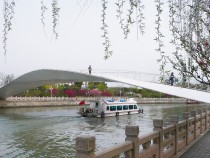
© Agence Mimram
DETAILstructure: You are a mathematician, engineer, architect and philosopher by education and training. How did you arrive at this level of diversity and how has it influenced your work?
Marc Mimram: I studied mathematics and architecture in parallel, without previously knowing much about either of them. My intent was to build bridges and saw that as my future career. Because I was interested in complex structures, I switched to studying engineering and completed a master’s degree in structural engineering at Berkeley. After this I returned to architecture to graduate in this discipline and then studied philosophy. These subjects fit together very well for me. At the moment, I run a master’s course with the title “Structure and Architecture”, which is aimed at architecture and engineering students. It allows them to switch to the other profession after taking their first degree.
DETAILstructure: Your way of working has been described as hybrid – what does this term mean to you?
Marc Mimram: Firstly it expresses that I am an architect just as much as an engineer, but my way of working is hybrid in a broader sense: when I began, there was always one solution that was the most sensible for a given span. This was the case wherever the project might be in the world – one span, one solution. However, I believe this is absurd. The local geographical and social situations also need to be taken into account, which leads to more multilateral solutions. The structural engineering design of a bridge is only part of a larger context. It is always about the transformation of an existing situation.
Marc Mimram: I studied mathematics and architecture in parallel, without previously knowing much about either of them. My intent was to build bridges and saw that as my future career. Because I was interested in complex structures, I switched to studying engineering and completed a master’s degree in structural engineering at Berkeley. After this I returned to architecture to graduate in this discipline and then studied philosophy. These subjects fit together very well for me. At the moment, I run a master’s course with the title “Structure and Architecture”, which is aimed at architecture and engineering students. It allows them to switch to the other profession after taking their first degree.
DETAILstructure: Your way of working has been described as hybrid – what does this term mean to you?
Marc Mimram: Firstly it expresses that I am an architect just as much as an engineer, but my way of working is hybrid in a broader sense: when I began, there was always one solution that was the most sensible for a given span. This was the case wherever the project might be in the world – one span, one solution. However, I believe this is absurd. The local geographical and social situations also need to be taken into account, which leads to more multilateral solutions. The structural engineering design of a bridge is only part of a larger context. It is always about the transformation of an existing situation.




















